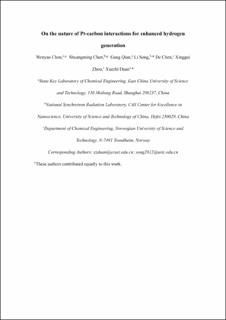| dc.contributor.author | Chen, Wenyao | |
| dc.contributor.author | Chen, S. M. | |
| dc.contributor.author | Qian, G. | |
| dc.contributor.author | Song, L. | |
| dc.contributor.author | Chen, De | |
| dc.contributor.author | Zhou, Xinggui | |
| dc.contributor.author | Duan, Xuezhi | |
| dc.date.accessioned | 2021-03-09T09:37:33Z | |
| dc.date.available | 2021-03-09T09:37:33Z | |
| dc.date.created | 2020-11-10T23:31:57Z | |
| dc.date.issued | 2020 | |
| dc.identifier.citation | Journal of Catalysis. 2020, 389 492-501. | en_US |
| dc.identifier.issn | 0021-9517 | |
| dc.identifier.uri | https://hdl.handle.net/11250/2732316 | |
| dc.description.abstract | Understanding the metal-support interactions in heterogeneous catalysis is critical yet complicated to tailor-design the catalysts with desirable properties. Exemplified with Pt-catalyzed ammonia borane (AB) hydrolysis, a dramatic increase of 20 folds in the catalytic activity is achieved by engineering the Pt-carbon interactions via adopting four different carbon materials (AC, CNT, f-CNF and p-CNF) as the catalyst supports. Multiple characterization techniques reveal that the Pt-carbon electronic interactions, including electron transfer and interfacial bonding, are deemed to be mainly responsible for the remarkable enhancement in the hydrogen generation rate. The molar ratio of electron-withdrawing group to electron-donating group (nEWG/nEDG) is further identified as a descriptor of catalyst in terms of Pt binding energy, which exhibits an almost linear relationship with the catalytic activity. Moreover, a comparison of Pt catalyst pre-treatments, i.e., H2 and AB reduction as well as Ar calcination, suggests that the Pt-O-C linkages within the Pt-carbon interactions are highly stable yet inferior to this reaction. As a result, combining the merits of the highest Pt binding energy as well as the minimum Pt-O-C linkages, the Pt/p-CNF delivers the highest catalytic activity. The insights presented here could shed new lights on the nature of Pt-carbon interactions, which could be extended to the design and manipulation of other metal-carbon catalysts. | en_US |
| dc.language.iso | eng | en_US |
| dc.publisher | Elsevier | en_US |
| dc.rights | Attribution-NonCommercial-NoDerivatives 4.0 Internasjonal | * |
| dc.rights.uri | http://creativecommons.org/licenses/by-nc-nd/4.0/deed.no | * |
| dc.title | On the nature of Pt-carbon interactions for enhanced hydrogen generation | en_US |
| dc.type | Peer reviewed | en_US |
| dc.type | Journal article | en_US |
| dc.description.version | acceptedVersion | en_US |
| dc.source.pagenumber | 492-501 | en_US |
| dc.source.volume | 389 | en_US |
| dc.source.journal | Journal of Catalysis | en_US |
| dc.identifier.doi | 10.1016/j.jcat.2020.06.028 | |
| dc.identifier.cristin | 1846751 | |
| dc.description.localcode | "© 2020. This is the authors’ accepted and refereed manuscript to the article. Locked until 2.7.2022 due to copyright restrictions. This manuscript version is made available under the CC-BY-NC-ND 4.0 license http://creativecommons.org/licenses/by-nc-nd/4.0/ " | en_US |
| cristin.ispublished | true | |
| cristin.fulltext | postprint | |
| cristin.qualitycode | 2 | |

